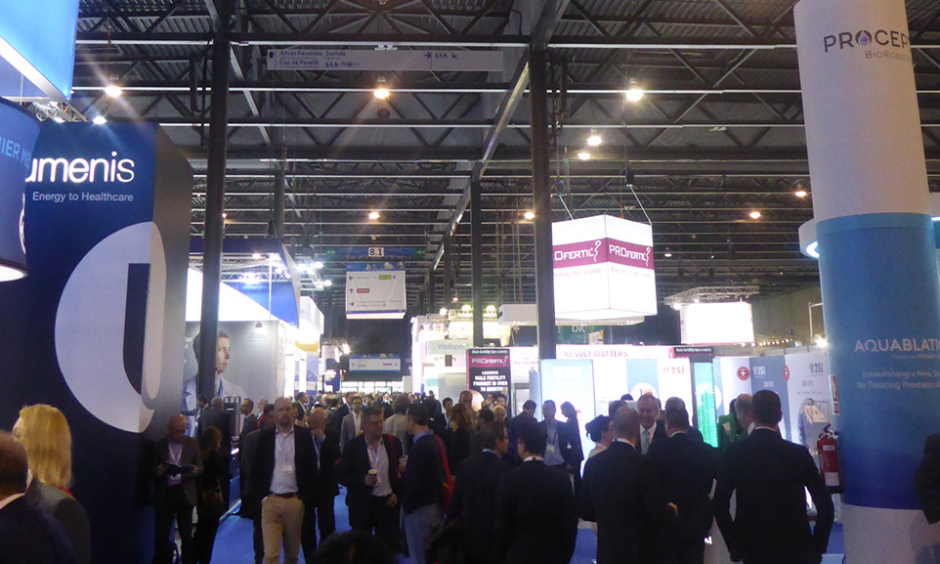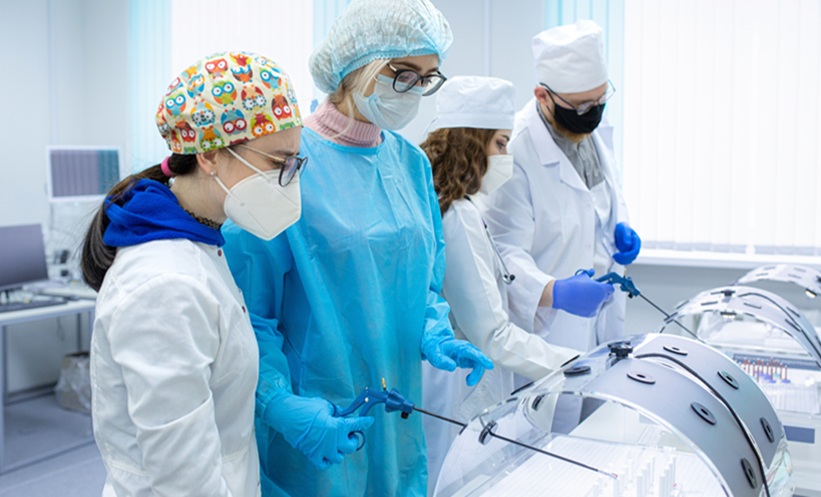This year’s EAU Congress featured a variety of innovative session formats, with the intention of providing all attendees with new and engaging ways to learn. The following session, suitably dubbed the ‘Nightmare Stones Session’, was one such format, offering a platform for Dr Marcel Fiedler to share a difficult case of laser lithotripsy that resulted in severe sepsis. The case was then cross examined by Mr Bertie Leigh, a medical lawyer and expert in medical litigation, who shed light on the legal connotations for the medical team. Finally, Dr John Denstedt was called upon to give his expert opinion about how this case should have been handled, before handing over to the audience for a brief Question and Answer session.
All medical procedures, particularly invasive ones, carry a risk of complications and it is only through sharing details of the most challenging cases that the medical society can learn and develop for the benefit of patients worldwide. While this session makes clear that, as Dr Denstedt highlighted, nothing is ever completely certain in medicine, it also emphasised that a lack of, or lack of adherence to, best practice guidelines can lead to difficulties.
THE PATIENT
The patient was a 56-year old female presenting with a renal stone in the left renal pelvis measuring 21 mm and three smaller stones (9 mm, 6 mm, and 4 mm) in the left lower calyx. She was a recurrent stone former, having had extracorporeal shock wave lithotripsy in both the 1980s and 1990s, as well as percutaneous nephrolithotomy (PCNL) of the right kidney. She had received extracorporeal shock wave lithotripsy of the left kidney in 2012.
THE CASE
Various treatment possibilities were discussed with the patient, who refused PCNL due to her previous bad experience with the procedure. Thus, flexible ureteroscopy was decided upon and pre-stenting was performed.
Day 1: The patient returned in 2 weeks, her urine and blood were tested and showed no signs of infection; therefore, the medical team performed flexible uretero-renoscopy (fURS) with laser lithotripsy; they dusted the larger stone in the renal pelvis and fragmented and removed the smaller stones in the lower calyx.
The procedure was uneventful and lasted for 118 minutes, after which a double J stent was placed, and an antibiotic prophylactic regimen was started.
That night, the patient developed a fever and shivering. White blood cell count and urine tests showed signs of infection. However, a chest X-ray was performed, and the results were unremarkable. Sonography was used and confirmed that the stent was positioned correctly. A follicle catheter was inserted to prevent reflux of urine through the stent.
Day 2: The patient still had a fever and their pulse had quickened.
Day 3: The patient rapidly deteriorated, with pulmonary function worsening, and she was moved to the intensive care unit. Tests showed multisensitive Escherichia coli in the urine and the blood. A chest X-ray once again ruled out pneumonia.
Day 5: The patient experienced pulmonary insufficiency and was intubated. A chest CT revealed pneumonia.
Day 8: The patient had developed acute kidney failure, which was hypothesised to be a result of multiorgan failure due to sepsis. As a result, dialysis was started. Creatinine levels were initially normal, but then went up to 6 or 7.
Day 10: The patient had deteriorated further, with gangrene of peripheral fingers/toes requiring surgery.
Day 18: The patient finally left intensive care. The double J stent was removed 7 days later, and the patient was discharged 1 month from the start of treatment. Continued dialysis was required.
THE CROSS EXAMINATION
Mr Leigh was invited to question Dr Fiedler about the case and did so forensically, highlighting areas of the treatment regimen which could be the basis for legal action on behalf of the patient.
Mr Leigh began by pointing out that the stone situated in the renal pelvis was very large, to such an extent that fURS was contraindicated. Dr Fiedler replied that while PCNL is the best option, guidelines show fURS to be the second-best choice. Mr Leigh retorted that this case ultimately represented an incidence of patient preference leading the clinicians to perform a procedure which they knew was inferior. In response, Dr Fiedler added that while stone clearance rate is better in PCNL, the literature shows that fURS can be a reasonable option in larger stones and does not necessarily have a higher complication rate than PCNL.
Mr Leigh’s next line of inquiry regarded the use of antibiotics, or, importantly, the lack thereof. Dr Fiedler referred to guidelines when asked why his team did not administer preoperative antibiotics to the patient, noting that the guidelines also recommend perioperative administration.
The extended duration of the procedure was also a cause for concern. Mr Leigh noted that the upper limit of safety for laser lithotripsy is 90 minutes, but this procedure continued for 118 minutes. Dr Fiedler defended his team’s decision by arguing that prolonging the treatment avoided the need for a second procedure to complete the lithotripsy, therefore preventing complications associated with anaesthesia. However, Dr Leigh countered this point by stating the incredibly low mortality rate associated with uncomplicated, elective anaesthesia.
Finally, Mr Leigh also lamented that no microbiologist was consulted with a full patient history and, instead, the clinicians awaited the results of urine and blood cultures.
ADDITIONAL DISCUSSION
Dr Denstedt evaluated the case in further detail, considering what the best-case practice would have been. He initially commented that both EAU and American Urological Association (AUA) guidelines stated that PCNL was the procedure of choice for stones >2 cm. As the patient had presented with a stone volume of at least 3–4 cm, Dr Denstedt suggested that the patient might have been treated with the wrong procedure and that the treatment options should have been discussed in more detail with the patient. Having said that, he conceded that flexible ureteroscopy was growing in popularity for larger stones and that the envelope was increasingly being pushed in this regard.
Moving on, Dr Denstedt homed in on sepsis as the real issue with the presented case. He discussed that although sepsis typically had a low incidence rate, its associated mortality rate was high and therefore it was crucial to understand some of the risk factors for sepsis. Some of the risk factors he highlighted were:
- Lengthy operation (>90 minutes).
- If the patient has diabetes or other comorbidities.
- Stent put in ahead of time.
- A positive urine culture.
Dr Denstedt then explained that there were several practices, or lack of practices, in this case that had increased the risk of postoperative sepsis. There were no prophylactic antibiotics and a stent was put in ahead of time.
Further discussing prophylactic antibiotics, Dr Denstedt declared that the lack of antibiotic prophylaxis in this case was not ideal. He drew on the EAU and AUA guidelines as evidence, which both recommend the use of prophylactic antibiotics. Dr Denstedt said that the debate was really whether the antibiotics should be delivered intravenously or orally and that, in his practice, they used a single dose of intravenous antibiotics prior to the operation. On this note, Dr Denstedt urged the audience not to overuse antibiotics, suggesting that urologists were probably still using too many doses.
Dr Denstedt concluded by providing a summary of his main tips:
- Ensure you obtain a preoperative urine culture and treat any infection.
- Obtain a stone culture when possible. This may be more predictive of postoperative sepsis than a urine culture. However, it does take additional time after the operation to get the results of a stone culture and it may not always be practical to wait.
- Avoid routinely stenting the patient.
- Keep kidney pressure down. In Dr Denstedt’s practice, the clinicians consider doing this when the patient is suspected to be at high risk of developing sepsis.
- Ensure operation times are not overly long.
REAL-WORLD PRACTICE
The natural uncertainty inherent to the practice of medicine was highlighted when Mr Leigh challenged the attendees on whether they would cancel the operation if results from a urine culture were not available. With most of the audience stating they would continue with the operation if the results were not available, Mr Leigh questioned this practice and the value of the urine culture.
Dr Denstedt interjected at this point, noting that nothing was ever completely certain in medicine and, furthermore, not every patient should be treated in the same way. He gave two contrasting examples:
- A young totally healthy individual with no prior history of infection.
- A patient with diabetes and a history of infections in the past.
Dr Denstedt noted that it would be far more plausible to proceed with the operation without results from a urine culture in the case of the first patient.
However, it was noted that one should blend such a patient-specific approach with due regard for the relevant guidelines. Dr Denstedt highlighted that although personalised medicine was currently a very hot topic, in his experience, failure to standardise approaches led to uncertainty and problems later on. He specifically pointed to the case that had been presented, noting that the guidelines gave clear recommendations.
AUDIENCE QUESTIONS
Is there any definition of an operation time that is ‘too long’?
Dr Fiedler acknowledged that this was a pertinent question and that this issue came down to good clinical practice rather than evidence. He turned to Dr Denstedt for an explanation of his own practice. Reflecting on this, Dr Denstedt commented that patients were presenting with larger and larger stones and longer ureteroscopy operations were being conducted. In his practice, it was felt that 90 minutes represented the limit. After this, he believed that complication rates, such as sepsis, began to increase. Therefore, he would tend to end an operation by the 90-minute mark and bring a patient back 2–3 weeks later if necessary.
I think we all agree that urine cultures are important beforehand. However, what about the timing of those cultures? In real-world practice, sometimes the culture can be 3 months beforehand. What do you do in that situation?
Dr Denstedt agreed with the significance of this point. He highlighted that, in his own practice, the pre-admission programme was designed so that the culture was conducted a week before. However, if the aforementioned situation were to arise, he believed another culture should be taken as there was too much of a risk that the situation could have changed over 2–3 months.
If I use my own previous experience as a justification for my practice (e.g., this has worked for X number of patients), how do I stand from a legal perspective?
Mr Leigh strongly rebuffed the idea that this would be a suitable legal defence. He answered that lawyers would ask medical experts to advise them in such an instance and that the experts would tend to base their responses on the results of large, double-blind clinical trials rather than anecdotal evidence from individual practitioners.








